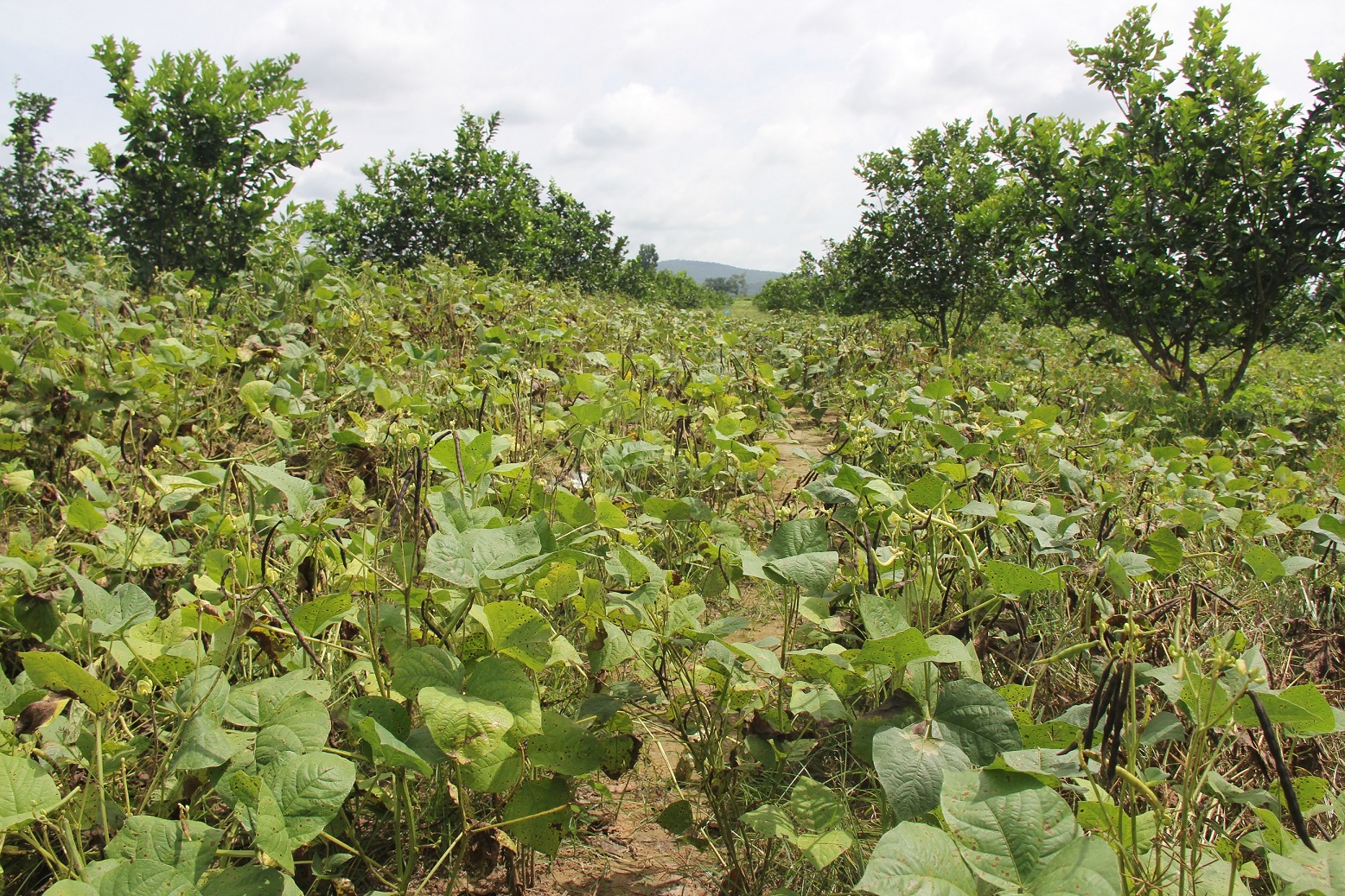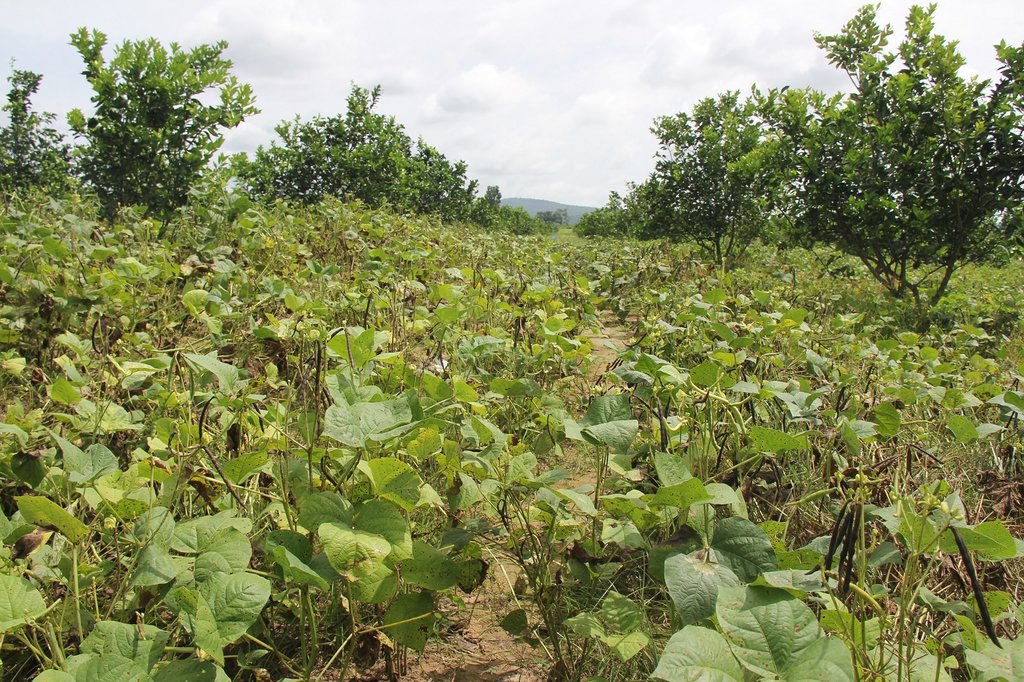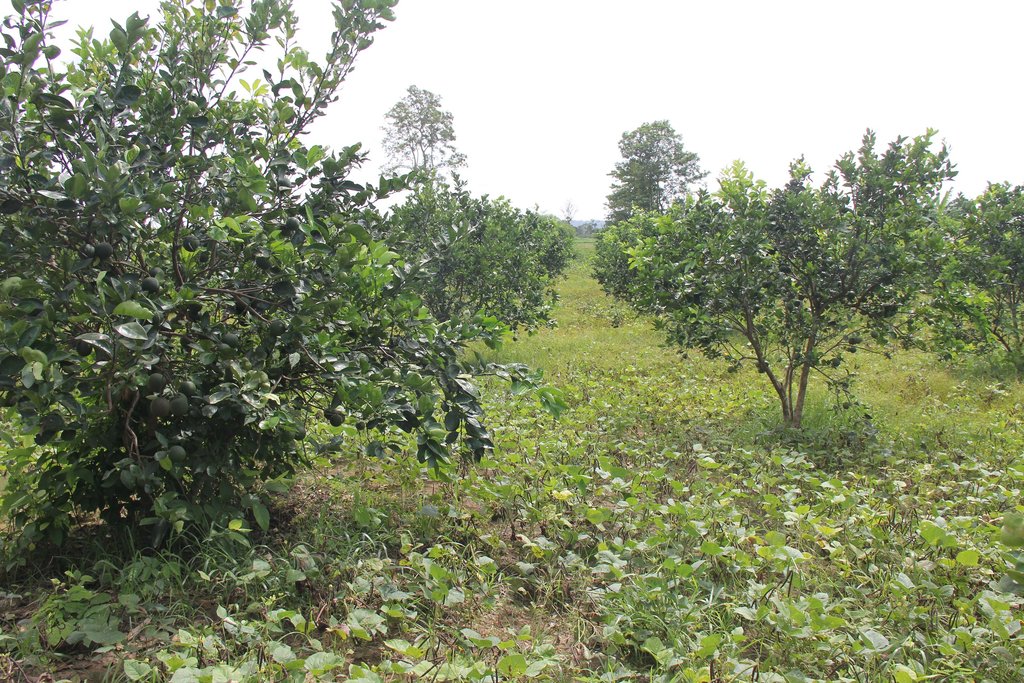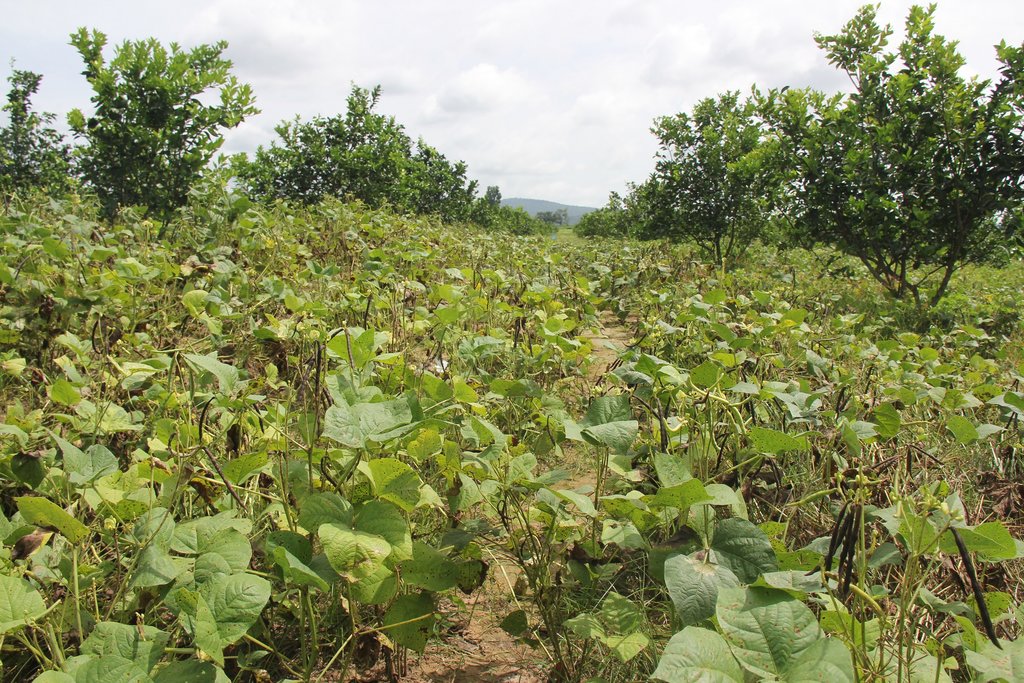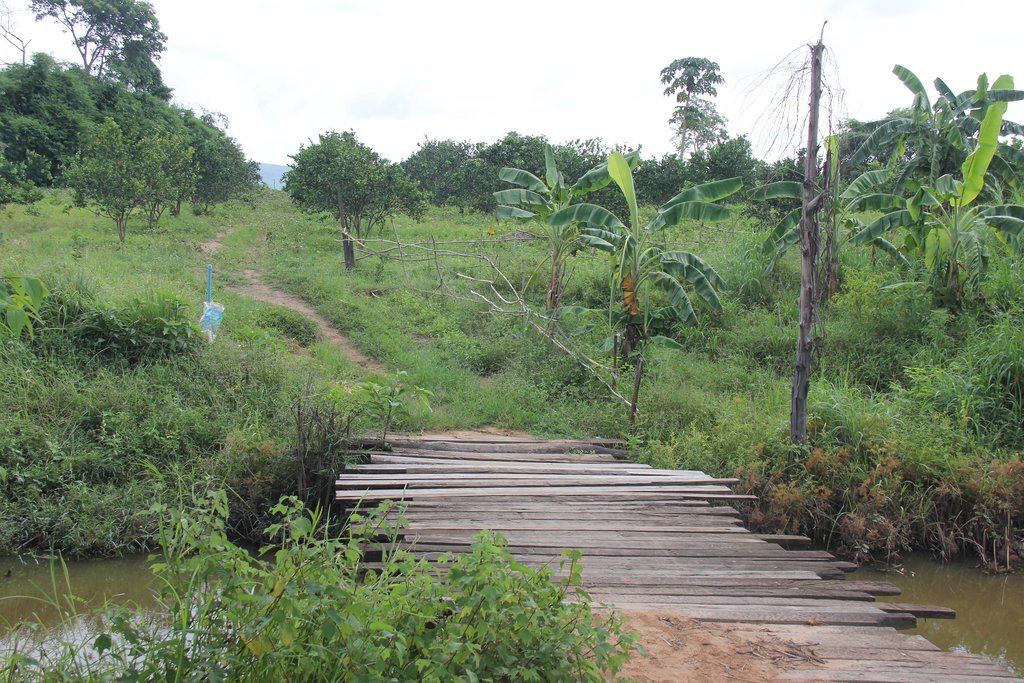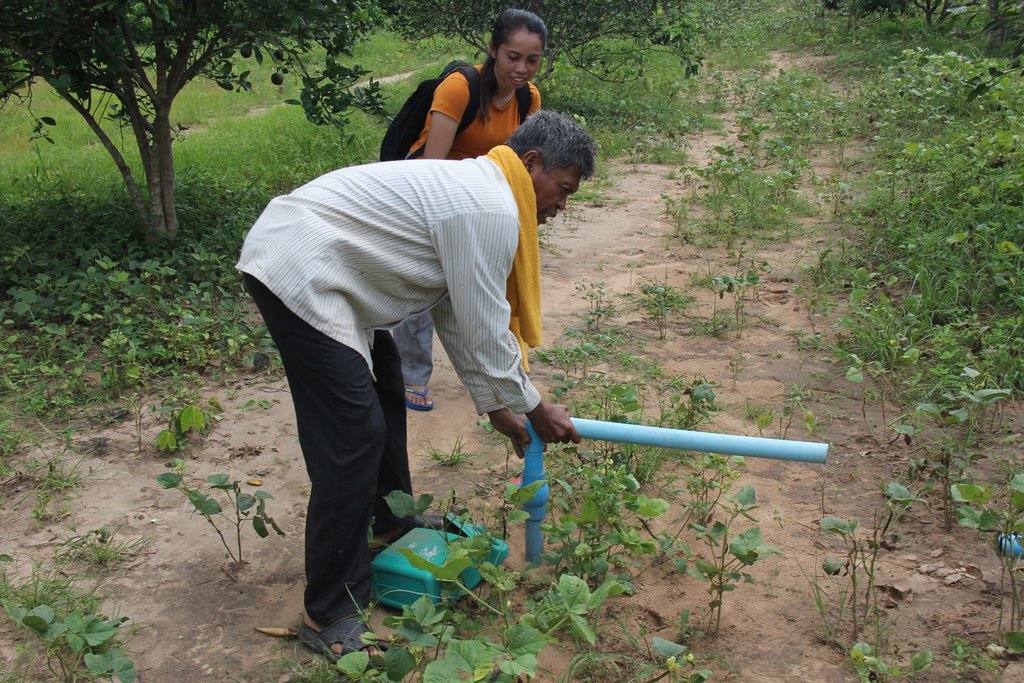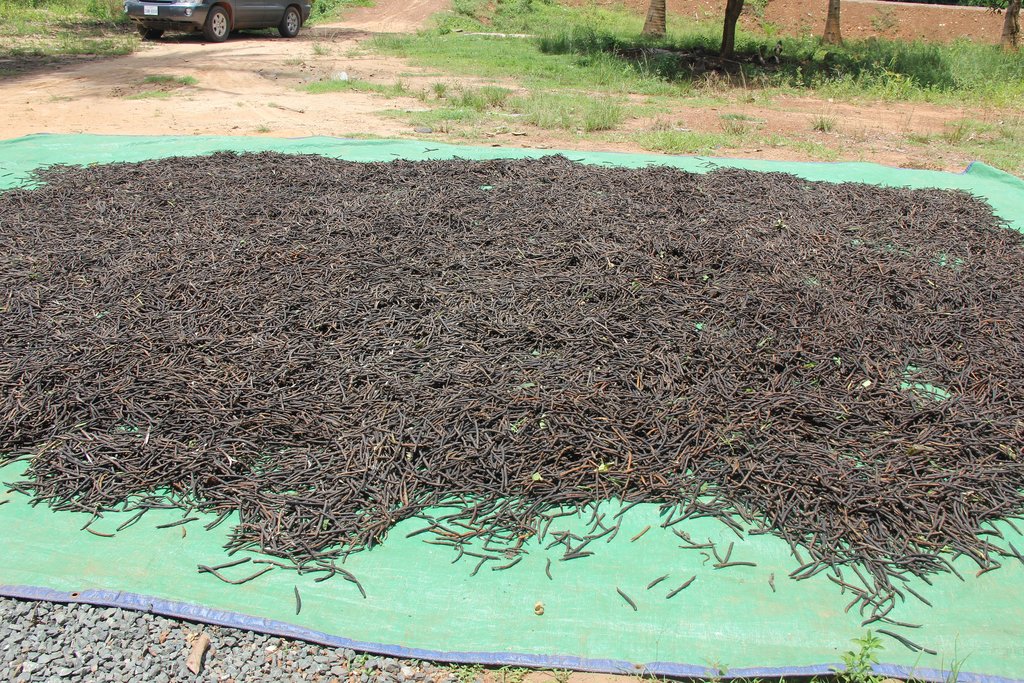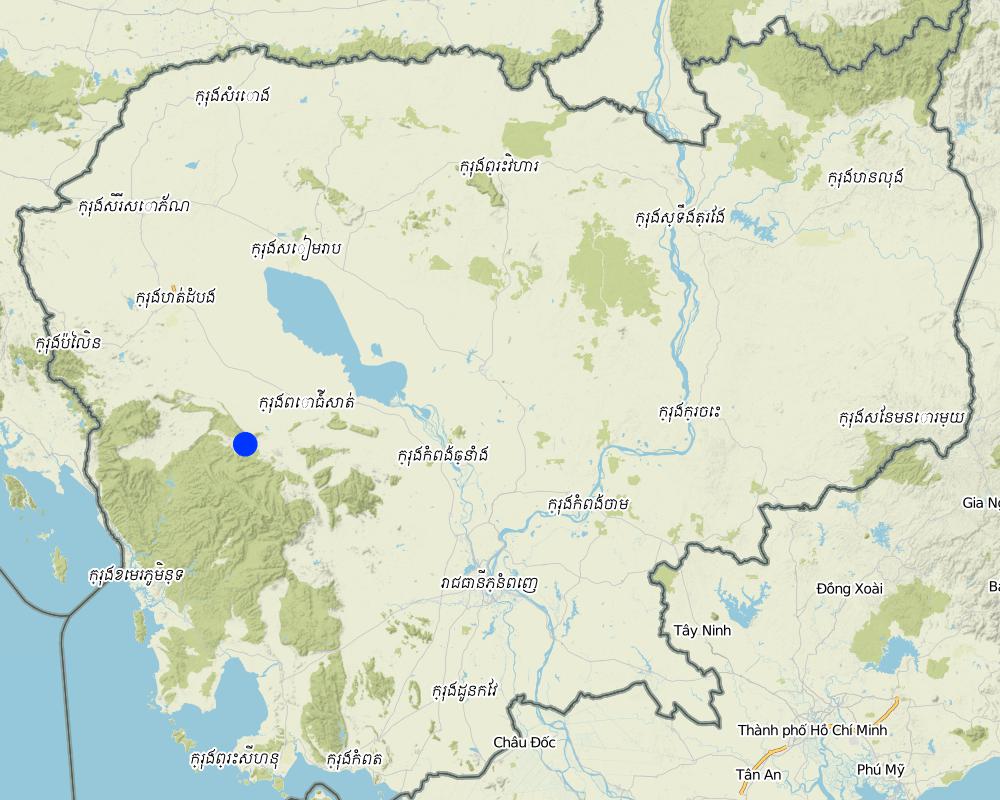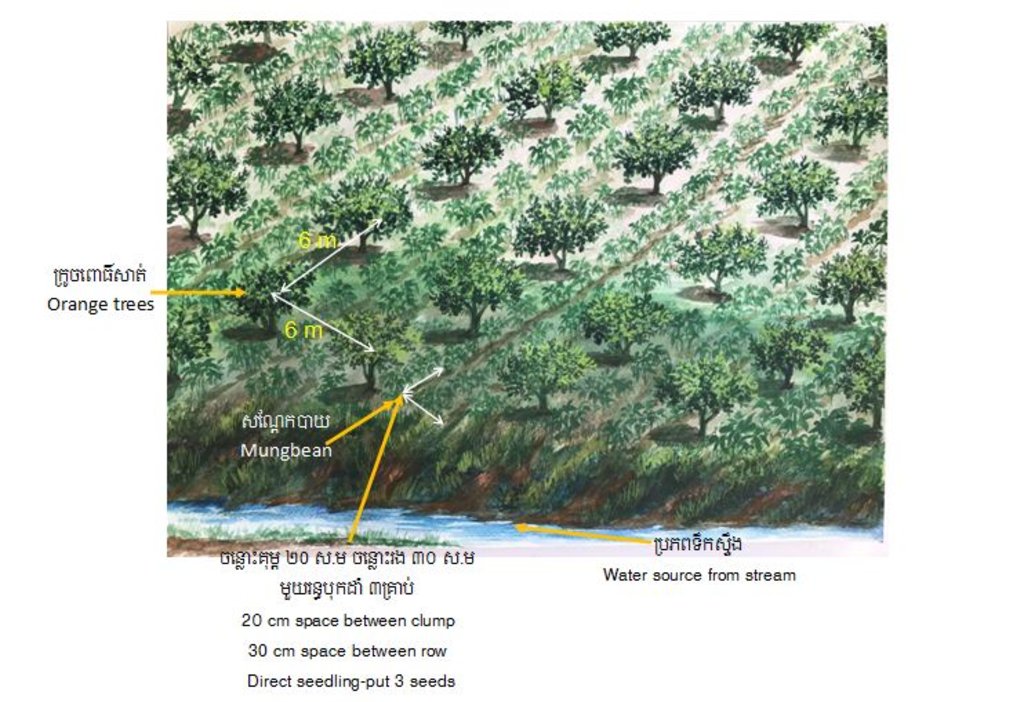Intercropping of orange trees with mungbean in mountainous areas [Cambodia]
- Creation:
- Update:
- Compiler: Navin Chea
- Editors: Sophea Tim, Sok Pheak
- Reviewers: Nimul CHUN, SO Than, Ursula Gaemperli, Alexandra Gavilano
Intercropping
technologies_3146 - Cambodia
View sections
Expand all Collapse all1. General information
1.2 Contact details of resource persons and institutions involved in the assessment and documentation of the Technology
Key resource person(s)
land user:
Chea Sarith
Land User
Cambodia
Acting Chief of District Office of Agriculture, Forestry and Fisheries, Phnum Kravanh:
Doung Phanny
District Office of Agriculture, Forestry and Fisheries, Phnum Kravanh.
Cambodia
Chief Office of Agricultural Extension at Provincial Department of Agriculture, Forestry and Fisheries, Pursat:
Chief of District Office of Agriculture, Forestry and Fisheries , Bakan:
Agronomic Official at District Office of Agriculture, Forestry and Fisheries , Kandieng:
Seng Kompheak
District Office of Agriculture, Forestry and Fisheries , Kandieng
Cambodia
Name of project which facilitated the documentation/ evaluation of the Technology (if relevant)
Scaling-up SLM practices by smallholder farmers (IFAD)Name of the institution(s) which facilitated the documentation/ evaluation of the Technology (if relevant)
Royal University of Agriculture (RUA) - Cambodia1.3 Conditions regarding the use of data documented through WOCAT
The compiler and key resource person(s) accept the conditions regarding the use of data documented through WOCAT:
Yes
1.4 Declaration on sustainability of the described Technology
Is the Technology described here problematic with regard to land degradation, so that it cannot be declared a sustainable land management technology?
No
2. Description of the SLM Technology
2.1 Short description of the Technology
Definition of the Technology:
Intercropping of mungbean between orange trees improves soil fertility and generates income before the orange trees bear fruit.
2.2 Detailed description of the Technology
Description:
Agroforestry is a farming practice that can involve growing of a mixture of woody perennials like trees, shrubs, palms, bamboos, etc. with crops and/or animals, on the same land-management units. Agroforestry systems play an important role in ecological and economical interactions between the different land use components (Lundgren and Raintree, 1982). It represents an interface between agriculture and forestry, and encompasses mixed land-use practices. Agroforestry systems are composed of three attributes:
1. Productivity (improved tree products, yields of associated crops, reduction of cropping system inputs, and increased labor use efficiency);
2. Sustainability (beneficial effects of woody perennials);
3. Adoptability (MoE/Adaptation Fund/UNEP, 2016).
In Cambodia, mungbean grows throughout the whole year almost, depending on the moisture factor. Mungbean is short maturity crop which can be grown both in sloping upland and in lowland areas. In upland areas farmers usually plant their second crop in August and harvest it in October. Mungbean is a crop that can be grown on many soil types, but grows best on alluvial, sandy, and volcanic soils which well drained containing high levels of nutrients (incl. N, P, K, Ca, Mg) and organic matter (MAFF, 2005). Mungbean crop duration depends on the variety, with short-term, medium-term and long-term being harvested between 60-65 days, 65-75 days, and 75-80 days, respectively.
Mungbean residues can make an active contribution to improvement of soil quality through nitrogen fixation and subsequent incorporation of this nitrogen into the soil after root and nodule degeneration by Rhizobium bacteria. The incorporation of the organic root material also improves the soil structure (MAFF, 2005, Chadha, 2010, IRRI-CIMMYT Alliance, 2009). The taproot of the mungbean can penetrate the soil to a depth of 50-60 centimeters. Sometimes, some land users grow mungbean as a green manure crop specifically to improve soil quality (Tauch Ung, 2010).
Mr. Chea Sarith is one example of land user who practices intercropping of orange trees with mungbean since 2013. The main purpose is to improve soil fertility, to prevent soil erosion, and to generate income before the orange trees provide fruit. In addition, it eases the weed control. After the harvest the farmer leaves the plant residues on the soil to provide organic matter. With the objective not to harm the roots of the orange trees, he avoids tilling the soil. In general, mungbean grows twice a season depending on the rainfall distribution and soil moisture.
The average yield of direct seeded mungbean as an intercrop between orange trees is about 1,200 kg/ha (harvested 3 times per crop). If mungbean is grown as a single crop the yield is usually ranges from 1,300 to 1,400 kg/ha. The market price for mungbean grain is usually about 4,500 to 5,000 Riel/kg.
Before planting orange trees the soil requires two turns of ploughing. After first ploughing the soil should dry during 1-2 months, before it can be ploughed again by a wheel harrow. Orange trees then are planted in rows into pits of 1 m x 1 m, with a depth of 70-80 cm. The spacing between the trees, as well as between the rows is usually 6 meters. Before planting, the orange tree seedlings (bought from outside) are usually kept at the farm site for 15 to 20 days, which to allow them to adapt to the conditions of the growing environment. The farmer installed a water pipe in the underground to irrigate the fruit orchard. The nearby stream serves as water source. After the tree plantation, mungbean is sown by direct seeding on the remaining bare soil. This is done by putting 3 to 4 seeds into the seed holes (3 to 4 cm sowing depth at a plant spacing of 20 cm and a row spacing of 30 cm. After harvest the residues of the mungbean plants are squashed by machine and left to rot on the soil surface until is the next mungbean cycle starts by direct seeding.
2.3 Photos of the Technology
2.5 Country/ region/ locations where the Technology has been applied and which are covered by this assessment
Country:
Cambodia
Region/ State/ Province:
Ongkrong Village, Samrong Commune, Phnum Kravanh District, Pursat Province.
Further specification of location:
Phnum Kravanh of Cambodia.
Specify the spread of the Technology:
- evenly spread over an area
If precise area is not known, indicate approximate area covered:
- < 0.1 km2 (10 ha)
Map
×2.6 Date of implementation
Indicate year of implementation:
2013
2.7 Introduction of the Technology
Specify how the Technology was introduced:
- through land users' innovation
- during experiments/ research
Comments (type of project, etc.):
Through farmers experience, investigation on cropping and natural fertilizer application.
3. Classification of the SLM Technology
3.1 Main purpose(s) of the Technology
- improve production
- reduce, prevent, restore land degradation
- create beneficial economic impact
3.2 Current land use type(s) where the Technology is applied
Land use mixed within the same land unit:
Yes
Specify mixed land use (crops/ grazing/ trees):
- Agroforestry

Cropland
- Annual cropping
- Tree and shrub cropping
Annual cropping - Specify crops:
- legumes and pulses - beans
Tree and shrub cropping - Specify crops:
- citrus
Number of growing seasons per year:
- 1
Specify:
Orange trees belong to the long lifespan crop which provide fruit at the age of 4 years. The lifespan of getting fruits is approximately 20 years. Then in general, the farmer cuts the trees down and grow it again. However, it depends on the yield it provides. Mungbean can be harvested within two months and half and can be harvested 3 times per crop cycle.
Comments:
Orange and mungbean.
3.3 Has land use changed due to the implementation of the Technology?
Has land use changed due to the implementation of the Technology?
- Yes (Please fill out the questions below with regard to the land use before implementation of the Technology)

Forest/ woodlands
Comments:
Degraded forest, soil from termite mound.
3.4 Water supply
Water supply for the land on which the Technology is applied:
- mixed rainfed-irrigated
Comments:
There is a stream near the farm for supply the water for orange trees.
3.5 SLM group to which the Technology belongs
- agroforestry
- improved ground/ vegetation cover
3.6 SLM measures comprising the Technology

agronomic measures
- A1: Vegetation/ soil cover
- A3: Soil surface treatment

structural measures
- S7: Water harvesting/ supply/ irrigation equipment
3.7 Main types of land degradation addressed by the Technology

soil erosion by wind
- Et: loss of topsoil

chemical soil deterioration
- Cn: fertility decline and reduced organic matter content (not caused by erosion)

physical soil deterioration
- Pc: compaction

biological degradation
- Bc: reduction of vegetation cover
- Bl: loss of soil life
3.8 Prevention, reduction, or restoration of land degradation
Specify the goal of the Technology with regard to land degradation:
- prevent land degradation
- restore/ rehabilitate severely degraded land
Comments:
The former degraded forest soil was rehabilitated by the rotten residues of the mungbean, the deep penetration of its taproots, and by the nitrogen fixation through the symbiotic association of nitrogen fixing bacteria in the nodular roots of the mungbean. Thus, the soil structure and the soil fertility were improved little by little.
4. Technical specifications, implementation activities, inputs, and costs
4.1 Technical drawing of the Technology
Technical specifications (related to technical drawing):
The area of implementing this technology is 4 hectares with 1096 orange trees. The pit of planting orange trees is 1m x 1m, with a depth of 70-80 cm. The spacing between trees and between rows is usually 6 meters to get enough sunlight. The mungbean is planted by direct seedling by inserting 3 to 4 seeds per hole (the hole is 3-4 cm in depth). The spacing between the holes is 20 cm and the row spacing is 30 cm. The farmer of this farm also installed an irrigation system by setting up a pipe under the ground.
Author:
Mr. Khoun Sophal
Date:
05/07/2017
4.2 General information regarding the calculation of inputs and costs
Specify how costs and inputs were calculated:
- per Technology area
Indicate size and area unit:
4 hectares
other/ national currency (specify):
KHR (Riel)
If relevant, indicate exchange rate from USD to local currency (e.g. 1 USD = 79.9 Brazilian Real): 1 USD =:
4000.0
Indicate average wage cost of hired labour per day:
20000
4.3 Establishment activities
| Activity | Timing (season) | |
|---|---|---|
| 1. | Clear degraded forest | January |
| 2. | Clear the termite mound to flatten the area | Dry season |
| 3. | Drying the soil by sunlight | Dry season |
| 4. | Buy orange trees and adapt them to the condition of the area | Dry season |
| 5. | Planting orange trees | August |
4.4 Costs and inputs needed for establishment
| Specify input | Unit | Quantity | Costs per Unit | Total costs per input | % of costs borne by land users | |
|---|---|---|---|---|---|---|
| Labour | Clear the degraded forest soil | Person-day | 80.0 | 2000.0 | 160000.0 | 100.0 |
| Labour | Collect the residue of forest and then burn | Person-day | 60.0 | 20000.0 | 1200000.0 | 100.0 |
| Labour | Clear 40 termite mounds in 4 hectares | Person-day | 48.0 | 20000.0 | 960000.0 | 100.0 |
| Labour | Hire labor to carry the soil of termite mound to put in the hole of orange tree for planting | Person-day | 180.0 | 20000.0 | 3600000.0 | 100.0 |
| Equipment | Grass cutting marchine | piece | 2.0 | 1200000.0 | 2400000.0 | 100.0 |
| Equipment | Two wheel tractor | piece | 1.0 | 12000000.0 | 12000000.0 | 100.0 |
| Plant material | Orange seedlings | seedling | 1026.0 | 6000.0 | 6156000.0 | 100.0 |
| Construction material | Pumping machine | piece | 1.0 | 1200000.0 | 1200000.0 | 100.0 |
| Construction material | Irrigation system such as big tube, small tube etc | set | 1.0 | 8000000.0 | 8000000.0 | 100.0 |
| Other | Planting orange trees | Person-day | 51.0 | 20000.0 | 1020000.0 | 100.0 |
| Other | Pesticide sprayer machine | piece | 3.0 | 600000.0 | 1800000.0 | 100.0 |
| Other | Spraying pesticide hand pump sprayer | piece | 1.0 | 280000.0 | 280000.0 | 100.0 |
| Total costs for establishment of the Technology | 38776000.0 | |||||
| Total costs for establishment of the Technology in USD | 9694.0 | |||||
4.5 Maintenance/ recurrent activities
| Activity | Timing/ frequency | |
|---|---|---|
| 1. | Watering during dry season in the first year of planting orange trees | Two times per day during dry season |
| 2. | Spraying pesticides when there is present of insects on orange trees | Spray once time per season |
| 3. | Pruning some branches of orange trees | When the orange trees 2 years (One year cut some branches once time) |
| 4. | Apply organic fertilizer for the orange trees | When the orange trees are 4 years |
| 5. | Spray against weeds | Spray once time per half month. |
| 6. | Spray pesticides on mungbean plants | When mungbean flowering |
| 7. | Direct seeding of mungbean | August |
4.6 Costs and inputs needed for maintenance/ recurrent activities (per year)
| Specify input | Unit | Quantity | Costs per Unit | Total costs per input | % of costs borne by land users | |
|---|---|---|---|---|---|---|
| Labour | Watering the orange trees | Person-day | 11.0 | 20000.0 | 220000.0 | 100.0 |
| Labour | Pruning some branches of orange trees | Person-day | 100.0 | 20000.0 | 2000000.0 | 100.0 |
| Labour | Hire labor to spray pesticides | Person-day | 8.0 | 20000.0 | 160000.0 | 100.0 |
| Labour | Hire labor to harvest mungbean when mature | Person-day | 120.0 | 20000.0 | 2400000.0 | 100.0 |
| Plant material | Mungbean seed (1 hectare need 25 kg of mungbean) seeds) | hectare | 4.0 | 312500.0 | 1250000.0 | 100.0 |
| Fertilizers and biocides | Pesticides for orange trees | bottle | 4.0 | 40000.0 | 160000.0 | 100.0 |
| Fertilizers and biocides | Chemicals for improving of stem of mungbean | package | 60.0 | 1500.0 | 90000.0 | 100.0 |
| Fertilizers and biocides | Pesticide to kill worms on mungbean | bottle | 2.0 | 40000.0 | 80000.0 | 100.0 |
| Other | Direct seeding of mungbean | Person-day | 56.0 | 20000.0 | 1120000.0 | 100.0 |
| Total costs for maintenance of the Technology | 7480000.0 | |||||
| Total costs for maintenance of the Technology in USD | 1870.0 | |||||
Comments:
The maintenance costs then depend on the age of orange trees. The cost calculation of maintenance of orange trees is for year period, but the the recurrent costs for mungbean cultivation is calculated only for one crop cycle (two months and half).
4.7 Most important factors affecting the costs
Describe the most determinate factors affecting the costs:
The establishment of an orange tree orachard requires a lot of money.
5. Natural and human environment
5.1 Climate
Annual rainfall
- < 250 mm
- 251-500 mm
- 501-750 mm
- 751-1,000 mm
- 1,001-1,500 mm
- 1,501-2,000 mm
- 2,001-3,000 mm
- 3,001-4,000 mm
- > 4,000 mm
Specify average annual rainfall (if known), in mm:
1225.70
Specifications/ comments on rainfall:
In 2015 the annual rainfall is 1225.7 mm, in 2014 is 1128.1 and in 2013 is 1316 mm.
Indicate the name of the reference meteorological station considered:
Ministry of water resources and meteorology, 2015
Agro-climatic zone
- sub-humid
5.2 Topography
Slopes on average:
- flat (0-2%)
- gentle (3-5%)
- moderate (6-10%)
- rolling (11-15%)
- hilly (16-30%)
- steep (31-60%)
- very steep (>60%)
Landforms:
- plateau/plains
- ridges
- mountain slopes
- hill slopes
- footslopes
- valley floors
Altitudinal zone:
- 0-100 m a.s.l.
- 101-500 m a.s.l.
- 501-1,000 m a.s.l.
- 1,001-1,500 m a.s.l.
- 1,501-2,000 m a.s.l.
- 2,001-2,500 m a.s.l.
- 2,501-3,000 m a.s.l.
- 3,001-4,000 m a.s.l.
- > 4,000 m a.s.l.
Indicate if the Technology is specifically applied in:
- not relevant
Comments and further specifications on topography:
On Phnum Kravanh mountain area.
5.3 Soils
Soil depth on average:
- very shallow (0-20 cm)
- shallow (21-50 cm)
- moderately deep (51-80 cm)
- deep (81-120 cm)
- very deep (> 120 cm)
Soil texture (topsoil):
- coarse/ light (sandy)
Soil texture (> 20 cm below surface):
- coarse/ light (sandy)
Topsoil organic matter:
- medium (1-3%)
If available, attach full soil description or specify the available information, e.g. soil type, soil PH/ acidity, Cation Exchange Capacity, nitrogen, salinity etc.
PH=6
5.4 Water availability and quality
Ground water table:
5-50 m
Availability of surface water:
good
Water quality (untreated):
good drinking water
Is water salinity a problem?
No
Is flooding of the area occurring?
No
5.5 Biodiversity
Species diversity:
- medium
Habitat diversity:
- medium
5.6 Characteristics of land users applying the Technology
Sedentary or nomadic:
- Sedentary
Market orientation of production system:
- commercial/ market
Off-farm income:
- less than 10% of all income
Relative level of wealth:
- average
Individuals or groups:
- individual/ household
Level of mechanization:
- manual work
- mechanized/ motorized
Gender:
- men
Age of land users:
- middle-aged
5.7 Average area of land used by land users applying the Technology
- < 0.5 ha
- 0.5-1 ha
- 1-2 ha
- 2-5 ha
- 5-15 ha
- 15-50 ha
- 50-100 ha
- 100-500 ha
- 500-1,000 ha
- 1,000-10,000 ha
- > 10,000 ha
Is this considered small-, medium- or large-scale (referring to local context)?
- medium-scale
Comments:
The total crop land is 15 hectares.
5.8 Land ownership, land use rights, and water use rights
Land ownership:
- individual, titled
Land use rights:
- individual
Water use rights:
- open access (unorganized)
Comments:
There is free access of water stream nearby. He never has water usage conflict.
5.9 Access to services and infrastructure
health:
- poor
- moderate
- good
education:
- poor
- moderate
- good
technical assistance:
- poor
- moderate
- good
employment (e.g. off-farm):
- poor
- moderate
- good
markets:
- poor
- moderate
- good
energy:
- poor
- moderate
- good
roads and transport:
- poor
- moderate
- good
drinking water and sanitation:
- poor
- moderate
- good
financial services:
- poor
- moderate
- good
6. Impacts and concluding statements
6.1 On-site impacts the Technology has shown
Socio-economic impacts
Production
crop production
Comments/ specify:
The soil fertility was improved, so that the crop production increased steadily. In addition, the farmer now doesn't grow only orange trees, but he also grows mungbean.
crop quality
Comments/ specify:
The residues of mungbean contain many nutrients, which is suitable for getting good crop quality.
risk of production failure
Comments/ specify:
As the farmer plants more than one crop on the plot now, it reduces the production failure. This means that farmer get income from mungbeans before the orange trees provide fruits. The better weed control also reduces insects, which could be harmful to the crop.
product diversity
Comments/ specify:
There are mungbean and orange trees, now.
Income and costs
expenses on agricultural inputs
Comments/ specify:
Reduced chemical fertilizers on orange trees and mungbean, because after harvesting mungbean residues are kept on the soil which is very good green manure for soil.
farm income
Comments/ specify:
The farm income increases considerably due the intercropping system, as both mungbean and orange trees provide yield. In addition, mungbeans provide yield two times per year. Last but not least , mungbean play a key role as green manure which reduces the input of chemical fertilizers and therefore cost.
workload
Comments/ specify:
The mungbean and orange tree cultivation does not consume much of labor force because he doesn't have to spend a lot of time for weeding (as instead of weed mungbeans cover the soil now). On the other hand, the farmer mentioned that the orange plantation is time consuming at the beginning, when the orange trees has to be planted. As well the mungbean need more time at the moment when the plot has to be prepared for first direct seedling. But the technology as a whole entails not a lot of maintenance workload as he uses machinery such as pesticide sprayer machine and mungbean squash machine to facilitate the labor.
Socio-cultural impacts
food security/ self-sufficiency
Comments/ specify:
The diversification of the crops (oranges and mungbean) has considerably raised the income and therefore strongly prevent food insecurity situations.
health situation
Comments/ specify:
The reduction of chemical fertilizer and pesticides provides safer products that improves the health situation. In addition, mungbean and orange fruit deliver many nutrition benefits to human health.
community institutions
Comments/ specify:
He has joined the orange trees community to sell the orange fruits. Many researches are convinced of his success and the tastiness of his oranges; as for example researchers from the District Office of Agriculture, Forestry and Fisheries, Phnum Kravanh, Provincial Department of Agriculture, Forestry and Fisheries, Pursat etc.”
SLM/ land degradation knowledge
Comments/ specify:
By doing the farmer learned that degraded soil can be rehabilitated by the mean of mungbean residues acting as green manure. And from the moment the soil is rehabilitated he can see that this green manure prevents soil degradation at high degree.
Ecological impacts
Soil
soil moisture
Comments/ specify:
Mungbean and orange trees keep the soil moisture, prevent the evaporation to the atmosphere.
soil cover
Comments/ specify:
Orange trees and mainly the mungbean intercrop cover the soil almost entirely all year around.
soil compaction
Comments/ specify:
The residue of mungbean reduce soil compact by improving the soil structure through providing organic matter to the soil. The increased amount of soil organisms make the sol less compact.
soil organic matter/ below ground C
Comments/ specify:
The residues of mungbean left on the soil after harvesting are transformed to organic matter by the process of decay and therefore contribute essentially to increased soil organic matter.
Biodiversity: vegetation, animals
Vegetation cover
Comments/ specify:
Orange trees and mungbeans are the vegetation cover to avoid bare land, so the sunlight will not come directly to the the soil.
plant diversity
Comments/ specify:
There is more than one crop (orange trees and mungbean).
beneficial species
Comments/ specify:
Now, the soil is somewhat richer in termites, ants, earthworms, crickets ect.
habitat diversity
Comments/ specify:
Orange trees and mungbean cultivation promote soil organisms in the habitat.
6.3 Exposure and sensitivity of the Technology to gradual climate change and climate-related extremes/ disasters (as perceived by land users)
Gradual climate change
Gradual climate change
| Season | increase or decrease | How does the Technology cope with it? | |
|---|---|---|---|
| annual temperature | increase | well | |
| seasonal temperature | wet/ rainy season | increase | moderately |
| seasonal temperature | dry season | increase | well |
| annual rainfall | increase | moderately | |
| seasonal rainfall | wet/ rainy season | increase | moderately |
Comments:
Change in rainfall. If there is too much rain, the soil will be saturated and the root will be spoiled what reduces the yield of mungbean.
6.4 Cost-benefit analysis
How do the benefits compare with the establishment costs (from land users’ perspective)?
Short-term returns:
positive
Long-term returns:
positive
How do the benefits compare with the maintenance/ recurrent costs (from land users' perspective)?
Short-term returns:
positive
Long-term returns:
very positive
Comments:
When the orange trees grow bigger, it will provide very high income.
6.5 Adoption of the Technology
- 1-10%
Of all those who have adopted the Technology, how many did so spontaneously, i.e. without receiving any material incentives/ payments?
- 91-100%
6.6 Adaptation
Has the Technology been modified recently to adapt to changing conditions?
No
6.7 Strengths/ advantages/ opportunities of the Technology
| Strengths/ advantages/ opportunities in the land user’s view |
|---|
| Get income from the mungbean before orange trees provide fruit as a potential source of income. |
| The residues from the mungbean plants help to improve soil fertility. |
| The potential market of orange tree fruits is good, with traders buying directly from producers at the farm. |
| Strengths/ advantages/ opportunities in the compiler’s or other key resource person’s view |
|---|
| Residues of mungbean improve soil fertility, reduce soil degradation and help rehabilitate the degraded land. |
| In the initial 3 to 4 years of growth of orange trees it is important to grow short term crops like mungbean to provide an income source. |
6.8 Weaknesses/ disadvantages/ risks of the Technology and ways of overcoming them
| Weaknesses/ disadvantages/ risks in the land user’s view | How can they be overcome? |
|---|---|
| Orange trees require a lot of water. | Grow near a water source such as a stream or river, or dig ponds to hold water. Land users need to consider a potential water source. |
| When the soils become saturated due to excessive rain, the mungbean plant roots can degenerate and result in low grain yields and low grain price (due to poor grain quality). | There is little that farmers can do to improve the performance of the mung bean crop in conditions of soil moisture saturation. |
| Weaknesses/ disadvantages/ risks in the compiler’s or other key resource person’s view | How can they be overcome? |
|---|---|
| As the orange trees grow bigger there is reduced opportunity for intercropping with mungbean. | Grow intercrops that do not require much sunlight, such as ginger or galanga |
7. References and links
7.1 Methods/ sources of information
- field visits, field surveys
One place
- interviews with land users
one person.
- interviews with SLM specialists/ experts
4 persons
- compilation from reports and other existing documentation
When were the data compiled (in the field)?
04/07/2017
7.2 References to available publications
Title, author, year, ISBN:
Chadha, M. L. (2010). Short Duration Mungbean : A New Success in South Asia.
Available from where? Costs?
N/A
Title, author, year, ISBN:
MoE/Adaptation Fund/UNEP. (2016). Forest Restoration and Rehabilitation “ Enhancing Climate Change Resilience of Rural Communities Living in Protected Areas in Cambodia .”
Available from where? Costs?
Ministry of Environment(MoE). Free of charge.
7.3 Links to relevant online information
Title/ description:
MAFF. (2005). Mung bean.
URL:
Retrieved November 12, 2017, from http://www.maff.gov.kh/agri-tech/56-ដំណាំឧស្សាហកម្ម/ការដាំដុះសណ្តែក/1519-ដំណាំសណ្តែកបាយ.html
Title/ description:
Tauch Ung. (2010). Overiew of mung bean.
URL:
Retrieved November 12, 2017, from https://drive.google.com/file/d/0BwhP4tVirBPsOTM3OWFiMzktZTdmNi00NjMyLTg1NjktMzFhYzhmMzUyMjVl/view?hl=en
Title/ description:
IRRI‐CIMMYT Alliance. (2009).The importance of legumes in cereal cropping systems.
URL:
Retrieved November 12, 2017, from http://www.knowledgebank.irri.org/images/pdfs/the_importance_of_legumes_in_cereal_cropping_systems.pdf
Links and modules
Expand all Collapse allLinks
No links
Modules
No modules


